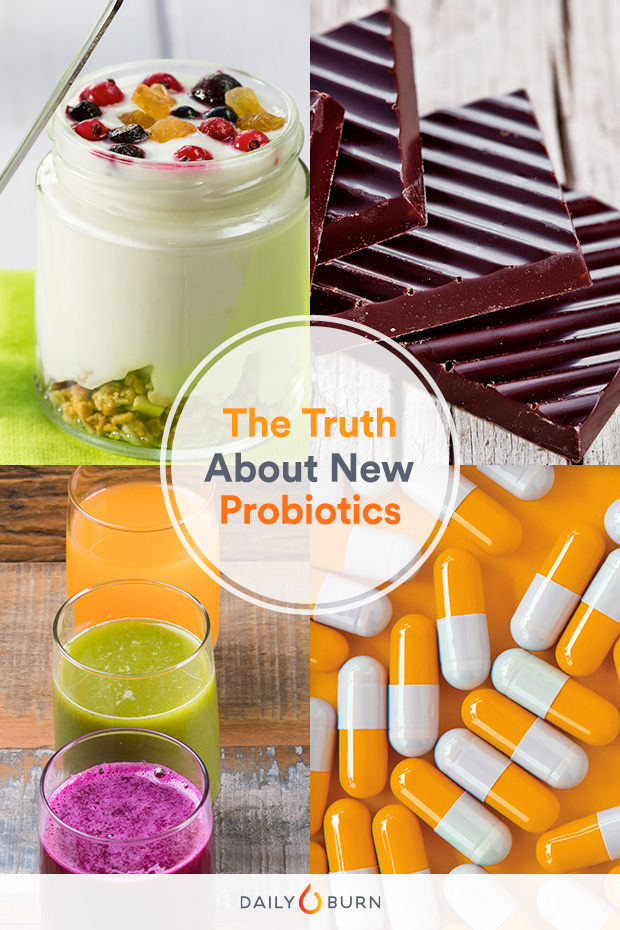
Got your gut on your mind? Then you’re probably up on the health benefits of probiotics. From boosting immunity to improving digestion, probiotics have been touted as the “superhero” of the gut bacteria underworld. And yet, there’s a lot we still don’t know about probiotics because the research is just heating up. To date, most studies that have been done on probiotics are on the Lactobacillus, Bifidobacterium and Streptococcus thermophilus strains. Meanwhile, there are, oh, upwards of 100 trillion gut-friendly bacteria out there — some of which are popping up in trendy new waters, chocolates, nut butters and more. Here’s what you need to know before giving your gut the royal treatment.
Not All Probiotics Are Created Equal
“There’s a world of a difference between getting a probiotic in a piece of chocolate versus a probiotic in yogurt.”
According to Bonnie Taub-Dix, MA, RD, CDN, founder of Better Than Dieting and author of Read It Before You Eat It, “We have more bacterial cells in our body than actual tissue, so you want as much “good” bacteria to be on your side. But not all probiotics are alike, and how your body reacts to them will not be the same as someone else who takes them.”
Taub-Dix recommends taking a probiotic (whether it’s a supplement, powder or food source) for a month, and if you don’t see any changes or improvements in your digestion, you can consider trying a different one. As far as the best source, Taub-Dix says there isn’t one.
“Since there are so many different types of probiotics, it depends on the best form that the probiotic survives in. For example, dairy forms of probiotics, like Greek yogurt and kefir, need to be refrigerated because that’s the best way for those probiotics to survive.”
RELATED: How to Choose the Best Protein Powder for You
What Does Your Gut Tell You?
The gut has trillions of microbes, which includes “good” and “bad” bacteria. When the balance of good and bad bacteria in your gut gets out of whack due to stress, medication changes or lack of sleep, our digestive health suffers and our immune system gets compromised.
You may find that you have more tummy troubles, like diarrhea, constipation, bloating or heartburn, or are prone to getting a cold when your gut flora is imbalanced.
“We tend to have an imbalance of good and bad bacteria when we’re taking an antibiotic, which kills the bad bacteria but also the good ones. Taking a probiotic while you’re undergoing antibiotic treatment will help replace some of the good bacteria and improve your overall digestive profile,” Taub-Dix explains.
RELATED: 9 All-Natural Sources of Healthy Probiotics
Probiotics 2.0: From Water to Chocolate
“…many products that have ‘probiotics’ on their label don’t actually have them.”
Eating more foods that are naturally rich in probiotics, like yogurt, kimchi and kefir, can help restore balance in your gut and create more “good” bacteria to fight off inflammation from “bad” bacteria. But what about food products that have probiotics infused into them? Indeed, manufacturers are banking on a new crop of gut-friendly products. From chocolates and granola bars to juices and tonics, nut butters, bottled water and even air sprays, you can’t escape the probiotic movement.
“When considering a probiotic food product, you have to look at the complete nutrient profile of the food. Look for what else the food is providing for you. There’s a world of a difference between getting a probiotic in a piece of chocolate versus a probiotic in yogurt,” Taub-Dix advises.
There are a lot of factors that play a role in how well probiotics survive before it actually hits your system. How long a store keeps the product in storage before selling it, the temperature at which you store the probiotic, the foods you eat the probiotic with, or the medications you take can affect the effectiveness of the probiotic. If you’re buying a product closer to its “Sell By” date, you might not reap the full benefits because that probiotic may not be as strong.
RELATED: How to Choose the Right Probiotic for You
The Problem With Probiotics
If it sounds too good to be true, then it probably is. Taub-Dix recommends to err on the side of caution when purchasing probiotic food products that tout over-the-top claims. The Food and Drug Administration (FDA) doesn’t regulate probiotics as its own food group. Instead, they’re regulated based on the form they take on: dairy products, dietary supplements and powders, or medical foods.
Your best bet: Look for products with the ‘Live Active Culture’ seal. “Probiotics is a buzzword, and many products that have ‘probiotics’ on their label don’t actually have them,” Taub-Dix warns.
The National Yogurt Association, who created this seal of approval, requires all yogurt manufacturers to include it on products that meet the standard of having a sufficient number of probiotics. The probiotics in store-bought yogurt need to meet this standard in order to be shelf-stable and reach your body alive. But even then, this standard isn’t all that useful in practice. The number just refers to the total number of live cultures and not the levels for each of those microbes. It’s possible, Taub-Dix says, that a product won’t have high enough levels of a certain probiotic to have any effect.
RELATED: Daily Burn Faceoff: Prebiotics vs. Probiotics?
The bottom line: Stick to trusted whole food sources of probiotics if you don’t know a probiotic supplement brand you trust. “Kimchi, pickled beets, Greek yogurt and sauerkraut are great sources of probiotics. If you don’t like them, throw them into a food you do like, like a smoothie, and add your favorite fruit to help mask the flavor,” Taub-Dix says.
